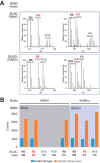Nic1 inactivation enables stable isotope labeling with 13C615N4-arginine in Schizosaccharomyces pombe
- PMID: 25368411
- PMCID: PMC4288259
- DOI: 10.1074/mcp.O114.045302
Nic1 inactivation enables stable isotope labeling with 13C615N4-arginine in Schizosaccharomyces pombe
Abstract
Stable Isotope Labeling by Amino Acids (SILAC) is a commonly used method in quantitative proteomics. Because of compatibility with trypsin digestion, arginine and lysine are the most widely used amino acids for SILAC labeling. We observed that Schizosaccharomyces pombe (fission yeast) cannot be labeled with a specific form of arginine, (13)C(6) (15)N(4)-arginine (Arg-10), which limits the exploitation of SILAC technology in this model organism. We hypothesized that in the fission yeast the guanidinium group of (13)C(6) (15)N(4)-arginine is catabolized by arginase and urease activity to (15)N1-labeled ammonia that is used as a precursor for general amino acid biosynthesis. We show that disruption of Ni(2+)-dependent urease activity, through deletion of the sole Ni(2+) transporter Nic1, blocks this recycling in ammonium-supplemented EMMG medium to enable (13)C(6) (15)N(4)-arginine labeling for SILAC strategies in S. pombe. Finally, we employed Arg-10 in a triple-SILAC experiment to perform quantitative comparison of G1 + S, M, and G2 cell cycle phases in S. pombe.
© 2015 by The American Society for Biochemistry and Molecular Biology, Inc.
Figures



Similar articles
-
Deletion of Genes Encoding Arginase Improves Use of "Heavy" Isotope-Labeled Arginine for Mass Spectrometry in Fission Yeast.PLoS One. 2015 Jun 15;10(6):e0129548. doi: 10.1371/journal.pone.0129548. eCollection 2015. PLoS One. 2015. PMID: 26075619 Free PMC article.
-
Construction, Growth, and Harvesting of Fission Yeast Stable Isotope Labeling by Amino Acids in Cell Culture (SILAC) Strains.Cold Spring Harb Protoc. 2017 Jun 1;2017(6):pdb.prot091678. doi: 10.1101/pdb.prot091678. Cold Spring Harb Protoc. 2017. PMID: 28572184
-
Stable Isotope Labeling by Amino Acids in Cell Culture (SILAC) Technology in Fission Yeast.Cold Spring Harb Protoc. 2017 Jun 1;2017(6):pdb.top079814. doi: 10.1101/pdb.top079814. Cold Spring Harb Protoc. 2017. PMID: 28572211
-
Response to leucine in Schizosaccharomyces pombe (fission yeast).FEMS Yeast Res. 2022 Apr 26;22(1):foac020. doi: 10.1093/femsyr/foac020. FEMS Yeast Res. 2022. PMID: 35325114 Free PMC article. Review.
-
Stable isotope labeling by amino acids in cell culture (SILAC) for quantitative proteomics.Adv Exp Med Biol. 2014;806:93-106. doi: 10.1007/978-3-319-06068-2_5. Adv Exp Med Biol. 2014. PMID: 24952180 Review.
Cited by
-
Phosphorylation of Influenza A Virus NS1 at Serine 205 Mediates Its Viral Polymerase-Enhancing Function.J Virol. 2021 Feb 24;95(6):e02369-20. doi: 10.1128/JVI.02369-20. Print 2021 Feb 24. J Virol. 2021. PMID: 33408177 Free PMC article.
-
Phosphorylation of JIP4 at S730 Presents Antiviral Properties against Influenza A Virus Infection.J Virol. 2021 Sep 27;95(20):e0067221. doi: 10.1128/JVI.00672-21. Epub 2021 Jul 28. J Virol. 2021. PMID: 34319782 Free PMC article.
-
Deletion of Genes Encoding Arginase Improves Use of "Heavy" Isotope-Labeled Arginine for Mass Spectrometry in Fission Yeast.PLoS One. 2015 Jun 15;10(6):e0129548. doi: 10.1371/journal.pone.0129548. eCollection 2015. PLoS One. 2015. PMID: 26075619 Free PMC article.
-
Growth and the Environment of Schizosaccharomyces pombe.Cold Spring Harb Protoc. 2016 Mar 1;2016(3):pdb.top079764. doi: 10.1101/pdb.top079764. Cold Spring Harb Protoc. 2016. PMID: 26933253 Free PMC article.
References
-
- Ong S. E., Mann M. (2005) Mass spectrometry-based proteomics turns quantitative. Nat. Chem. Biol. 1, 252–262 - PubMed
-
- Ong S. E., Blagoev B., Kratchmarova I., Kristensen D. B., Steen H., Pandey A., Mann M. (2002) Stable isotope labeling by amino acids in cell culture, SILAC, as a simple and accurate approach to expression proteomics. Mol. Cell. Proteomics 1, 376–386 - PubMed
-
- Olsen J. V., Blagoev B., Gnad F., Macek B., Kumar C., Mortensen P., Mann M. (2006) Global, in vivo, and site-specific phosphorylation dynamics in signaling networks. Cell 127, 635–648 - PubMed
Publication types
MeSH terms
Substances
Grants and funding
LinkOut - more resources
Full Text Sources

